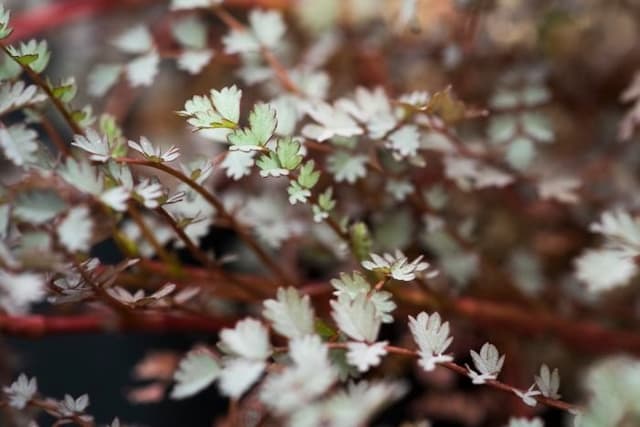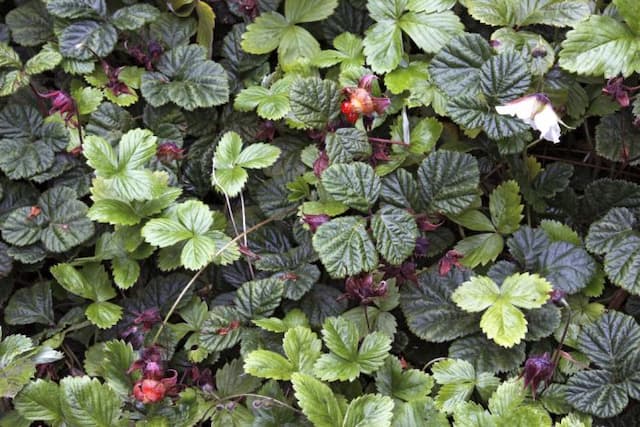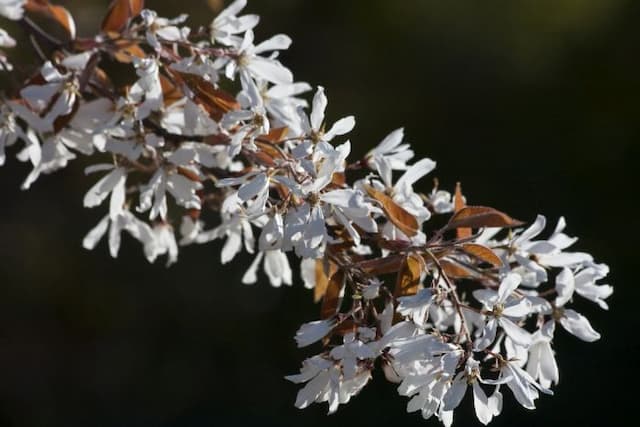Parney Cotoneaster Cotoneaster lacteus

ABOUT
Cotoneaster lacteus, commonly known as parney cotoneaster or milkflower cotoneaster, is an evergreen shrub known for its attractive aesthetic. This plant has arching branches that give it a rounded and spreading appearance. The foliage consists of dark green leaves that are glossy on the top surface, with a softer, white-felted underside, adding a textural contrast to the plant's overall look. What is particularly striking about this shrub are its flowers and berries. In the late spring to early summer, the parney cotoneaster becomes adorned with clusters of small, white flowers that have a subtle, sweet fragrance. These blooms are not only appealing to the eye but also attract a variety of pollinators, including bees. Following the flowering period, the plant produces bright red berries, which remain on the branches well into the winter months. These berries are a food source for birds and add a splash of color to the landscape, especially when contrasted against the plant's dark green leaves or against a backdrop of snow in colder regions. Throughout the seasons, the parney cotoneaster remains a visually appealing plant, offering year-round interest through its foliage, flowers, and fruiting bodies, which together create a delightful display in any garden setting where it is cultivated.
About this plant
 Names
NamesFamily
Rosaceae.
Synonyms
Parney's Cotoneaster, Milkflower Cotoneaster, Late Cotoneaster, Red Clusterberry.
Common names
Cotoneaster coriaceus, Cotoneaster lacteus var. typicus, Cotoneaster oliganthus, Cotoneaster parvifolius.
 Toxicity
ToxicityTo humans
Parney Cotoneaster (Cotoneaster lacteus) contains small amounts of cyanogenic glycosides, which can release cyanide when metabolized. Ingesting parts of the plant in small quantities might cause no or minimal symptoms. However, ingesting larger amounts can lead to poisoning, with symptoms that might include nausea, vomiting, abdominal pain, and dizziness. In severe cases, ingestion of significant quantities could result in more serious symptoms such as difficulty breathing, increased heart rate, lethargy, convulsions, and even coma. It is of utmost importance to seek immediate medical attention if a person suspects they or someone else has consumed a large amount of Parney Cotoneaster.
To pets
Parney Cotoneaster (Cotoneaster lacteus) is also considered toxic to pets due to its content of cyanogenic glycosides. While small amounts might not cause significant symptoms, ingestion of larger quantities by pets can lead to symptoms such as vomiting, diarrhea, trouble breathing, and weakness. In extreme cases, it can cause seizures, coma, and potentially even be fatal. If a pet ingests this plant, prompt veterinary care is crucial to manage the symptoms and prevent more severe outcomes. It is advised to keep pets away from Parney Cotoneaster to ensure their safety.
 Characteristics
CharacteristicsLife cycle
Perennials
Foliage type
Evergreen
Color of leaves
Dark green
Flower color
White
Height
6-8 feet (1.8-2.4 meters)
Spread
6-8 feet (1.8-2.4 meters)
Plant type
Shrub
Hardiness zones
7
Native area
China
Benefits
 General Benefits
General Benefits- Ornamental Appeal: Cotoneaster lacteus, commonly known as "Parney's Cotoneaster," has attractive evergreen foliage and red berries, making it a popular choice for garden landscapes and ornamental plantings.
- Wildlife Attraction: The berries provide a food source for birds, while the dense foliage offers shelter and nesting sites, supporting local biodiversity.
- Low Maintenance: Once established, Parney's Cotoneaster is drought-tolerant and requires little care, making it ideal for low-maintenance gardens.
- Erosion Control: Its extensive root system helps to stabilize soil and prevent erosion on slopes and banks.
- Hedge Plant: With its dense growth habit, it is commonly used for creating hedges and privacy screens.
- Seasonal Interest: The plant boasts year-round interest with evergreen leaves, spring flowers, and winter berries.
- Urban Tolerance: It is capable of withstanding urban pollution and is therefore suitable for city environments.
 Medical Properties
Medical PropertiesThis plant is not used for medical purposes.
 Air-purifying Qualities
Air-purifying QualitiesThis plant is not specifically known for air purifying qualities.
 Other Uses
Other Uses- Cotoneaster lacteus, commonly known as Parney's cotoneaster, can be used in landscaping as a hedging plant, providing an efficient and attractive natural barrier.
- The dense foliage of Parney's cotoneaster offers an excellent nesting site for various species of birds, which find both shelter and seclusion within its branches.
- The berries of Parney's cotoneaster provide a food source for birds, particularly during the winter months when other resources are scarce.
- Parney's cotoneaster can be shaped into topiary forms, making it a versatile decorative element in formal gardens and parks.
- The wood of Parney's cotoneaster is suitable for crafting small wooden items like handles and buttons due to its hardness and attractive grain.
- Dried branches of Parney's cotoneaster can be used in floral arrangements or as part of wreaths and other decorations for their lasting structure and subtle beauty.
- Including Parney's cotoneaster in a garden can attract beneficial insects, such as bees and butterflies, due to its flowers' nectar and pollen.
- The plant's dense growth habit can be instrumental in reducing soil erosion on slopes and banks when used as ground cover.
- Because of its ability to withstand pollution and harsh urban conditions, Parney's cotoneaster is ideal for use in city landscaping projects.
- The colorful autumn foliage of Parney's cotoneaster adds seasonal interest to gardens, with leaves turning red or orange before they fall.
Interesting Facts
 Feng Shui
Feng ShuiThe Cotoneaster is not used in Feng Shui practice.
 Zodiac Sign Compitability
Zodiac Sign CompitabilityThe Cotoneaster is not used in astrology practice.
 Plant Symbolism
Plant Symbolism- Resilience: Cotoneaster lacteus, commonly known as Parney's Cotoneaster, is an incredibly hardy plant that can thrive in various soil types and conditions. Its ability to survive in tough environments makes it a symbol of resilience and endurance.
- Protection: With its dense foliage and robust growth, Parney's Cotoneaster is often used as a hedge or barrier plant. It symbolically offers protection, creating safe havens or borders within gardens.
- Prosperity: The abundant bright red berries produced by Parney's Cotoneaster in the fall can symbolize prosperity and abundance. This aspect of the plant reflects the idea of a bountiful harvest and the rewards of hard work.
 Water
WaterThe Parney's Cotoneaster should be watered deeply and less frequently to encourage strong root development. Typically, providing about 1 to 1.5 gallons of water weekly during the growing season is adequate. During the hot summer months, you may need to water the plant twice a week, depending on the weather conditions. In winter, reduce watering to every few weeks, unless there are prolonged dry spells. It's important to allow the soil to dry out between waterings to prevent root rot. Overwatering can be as harmful as under-watering, so always check the soil moisture before adding water.
 Light
LightParney's Cotoneaster thrives in full sun to partial shade. The ideal spot for this plant is in an area where it can receive at least six hours of direct sunlight a day. While it can tolerate some shade, too little light can lead to sparse foliage and poor flowering. Avoid placing it in deep shade, as this can significantly impact its growth and health.
 Temperature
TemperatureParney's Cotoneaster is hardy and can withstand a range of temperatures. The ideal temperature range for this plant is between 35 to 85 degrees Fahrenheit. It can survive minimum temperatures down to about -10 degrees Fahrenheit, but growth will be best when conditions are within the ideal range. Avoid exposing the cotoneaster to sudden temperature changes and extremely hot conditions, as this can stress the plant.
 Pruning
PruningPruning Parney's Cotoneaster is important to maintain its shape and encourage healthy growth. Prune in late winter or early spring before new growth starts. Remove any dead, damaged, or diseased branches, and thin out dense areas to allow light and air to penetrate the plant. This promotes better foliage and reduces the risk of pests and diseases. Pruning can also be done to shape the plant or control its size; however, extensive pruning should be done over several seasons to avoid stressing the plant.
 Cleaning
CleaningAs needed
 Soil
SoilParney's Cotoneaster thrives in well-draining soil with a pH range of 6.0 to 7.5. A mix of loamy soil, peat, and coarse sand or perlite provides the ideal structure. Ensure organic content is incorporated for nutrient retention.
 Repotting
RepottingParney's Cotoneaster, being a large shrub, is not commonly repotted once planted outdoors. If grown in containers, young plants may be repotted every 2-3 years to refresh the soil.
 Humidity & Misting
Humidity & MistingParney's Cotoneaster is adaptable to a wide range of humidity levels and does not have specific humidity requirements. It can tolerate the normal humidity levels found in most outdoor environments.
 Suitable locations
Suitable locationsIndoor
Place Parney's Cotoneaster in bright, indirect light indoors; water moderately.
Outdoor
Plant Parney's Cotoneaster in full sun to partial shade and water regularly.
Hardiness zone
7-9 USDA
 Life cycle
Life cycleParney's Cotoneaster (Cotoneaster lacteus) begins its life cycle as a seed, which, upon finding suitable conditions, will germinate, typically in spring. The seedling then develops into a juvenile plant, establishing a root system and producing its first leaves. As it matures into an adult, it forms a woody, branching structure and dense foliage. During late spring to early summer, the adult plant flowers, producing small, white or pink blossoms that are attractive to pollinators. After pollination, these flowers develop into bright red berries by autumn, which persist through winter and can serve as food for birds and other wildlife. The plant continues to grow and can spread through rooting of lower branches or by seed dispersal, completing the cycle and contributing to the establishment of new Parney's Cotoneaster plants.
 Propogation
PropogationPropogation time
Spring to early summer
The Parney's Cotoneaster (Cotoneaster lacteus) can be propagated most commonly through semi-hardwood cuttings. This method involves taking cuttings from the current year's growth in the late summer, typically from July to early September. You should select healthy, disease-free branches and make cuttings roughly 4 to 6 inches (10 to 15 centimeters) long. Each cutting should have several leaves on the upper end and be cut just below a leaf node, as this is where the rooting hormone can be applied to encourage root development. The bottom end of the cuttings should then be dipped in rooting hormone powder or gel and planted in a well-draining potting mix. The pot containing the cuttings should be placed in a conservatory or a sheltered area outdoors with indirect light, and kept moist until roots have developed—usually in several weeks. After the cuttings have rooted and grown strong enough, they can be transplanted to their permanent location.









